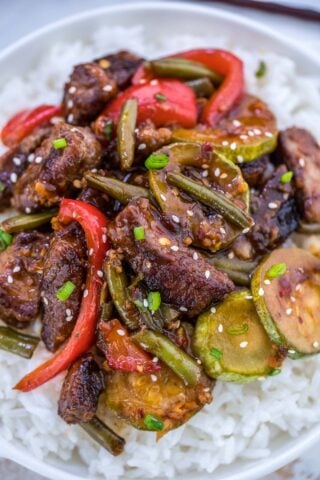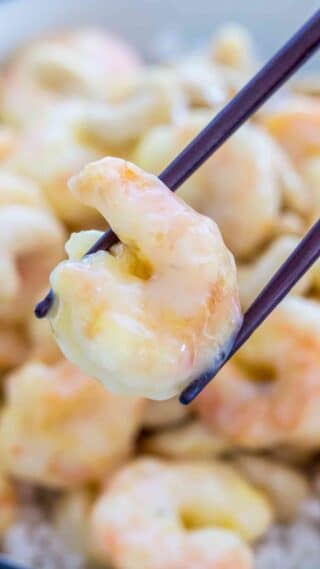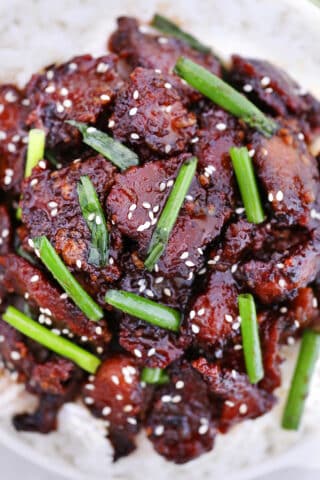Kung Pao Chicken Recipe
I love a good Szechuan recipe, and Kung Pao Chicken has always been one of my favorite Chinese takeout dishes. I have never imagined that recreating it at home can be so easy. This one-pan stir-fry recipe comes together in just 30 minutes and captures the essence of a classic Chinese dish. Vibrant and crisp veggies, tender and crispy meat, and crunchy peanuts, all tossed in a sweet, savory, and spicy sauce!
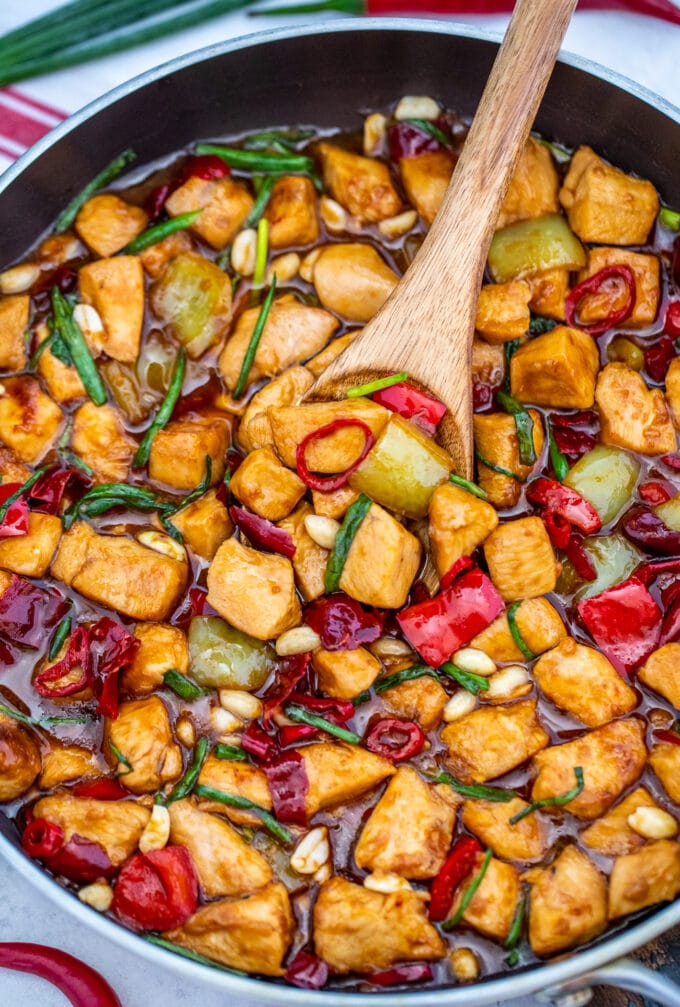
This Asian recipe is the perfect choice for when I crave something full of flavor but without the hassle. This recipe is easy to make and tastes indulgent, but it is also wholesome and nutritious. I usually serve it with perfectly cooked white rice and oven-roasted bok choy. Homemade Kung Pao Chicken is proof that comfort can taste good and also make you feel good!
Table of contents
This is such an effortless meal that it’s easy to prepare on a weeknight. It will take less time if you make it home than waiting for delivery. To achieve that silky texture, I marinate the meat in a cornstarch-based mixture. Then, I stir-fry the veggies, make the sauce, and combine everything. The sauce is thick and rich, with a hint of sweetness and the spiciness characteristic of dishes from Sichuan Province in China.
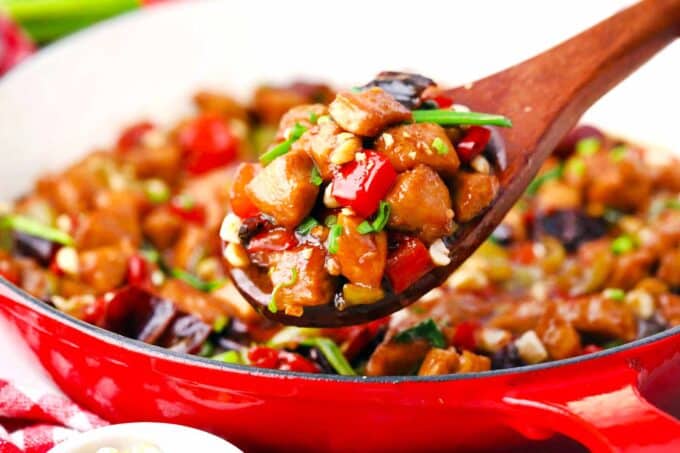
Why you will love this recipe
- Restaurant-quality for a budget price: When I get Kung Pao chicken at my favorite Chinese restaurant, they serve it hot, spicy, and with a generous pile of steaming rice. I serve it the same way, but mine is fresher and has no MSG. I can make it to order, and it’s also excellent served on noodles, cauliflower rice, or with vegetables. It also costs just a fraction of the price when I make it myself.
- I can make it as hot and spicy as I like. Depending on the type of chili peppers I use, the dish will be as hot as they are. This includes both the dried and fresh chilies. For the dried version, ancho chilies are the mildest, and for the fresh version, poblano peppers are the mildest type for that purpose.
- It’s fast and easy to make: in under 30 minutes, with just a few easy steps to follow, my Kung Pao chicken recipe is perfect for both beginners and experienced cooks. Either way, this dish turns out delicious every time without any special skills or tools.
- Authentic recipe: The only difference is that I don’t use moist, unroasted peanuts. I prefer to have them already roasted rather than having to fry them myself. Everything else is done just as it was originally in the Sichuan version.
What you will need
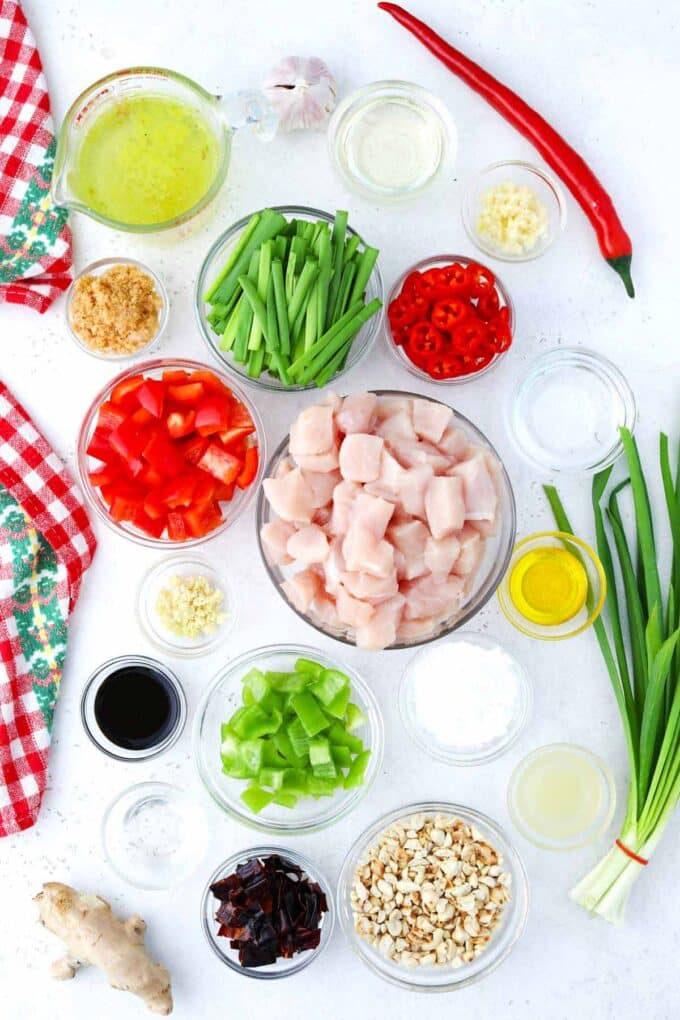
Marinade
For the marinade, I mix soy sauce with dry sherry to add a complex, nutty taste and a slight acidity, which tenderizes the meat, making it juicy and tangy without being overly sweet. I also add rice vinegar, which provides a nice sweetness and tangy flavor without being overpowering. Add sesame oil and cornstarch, which protect the chicken from excess heat and help the coating stick better.
Kung Pao sauce:
This is a complex and rich sauce made with chicken broth, soy sauce, and dark soy sauce for a deeper color and a more savory flavor. I also add balsamic vinegar and dry sherry to complement the sweetness of other ingredients and balance the spiciness.
Another sweet and savory sauce I add is hoisin sauce, which adds layers of complexity, giving depth and intrigue to this dish. I like to use a bit of light brown sugar to give it extra richness. Plus, cornstarch to help thicken it, and water.
The stir-fry:
- Chicken: I use 2 pounds of boneless, skinless chicken breast cut into 1-inch cubes. I also use vegetable oil for the stir-fry.
- Veggies: I only use half a red bell pepper and green bell pepper, seeded and diced. Save the rest for a salad or garnish.
- Spicy peppers: For this recipe, I use 10 dried chilies cut into half-inch pieces. I also love to add fresh red chili peppers; I get the larger ones that are milder in flavor.
- Aromatics: This dish needs the fresh minced garlic taste for a boost of robust umami flavor. Plus, freshly grated ginger adds a vibrant warmth with a bit of dynamic sweetness. I use green onion for a fresh pop of green color and a slight peppery flavor.
- Peanuts: My kids’ favorite part of this dish is the peanuts. I use roasted peanuts for a crunchy and nutty addition to a delicious dish.
How to make
Marinate the chicken: First, I combine all the marinade ingredients in a shallow bowl. Then, I put the chicken cubes in, mix them around, and marinate, covered, for at least 30 minutes.

Make the sauce: When I’m ready to cook, I mix the sauce ingredients in a medium bowl until the sugar has dissolved.

Cook the chicken: Now, I heat two tablespoons of oil in the wok over high heat. Once it’s sizzling, I fry the chicken for about 3 to 5 minutes, until it’s golden brown, and then set it aside.
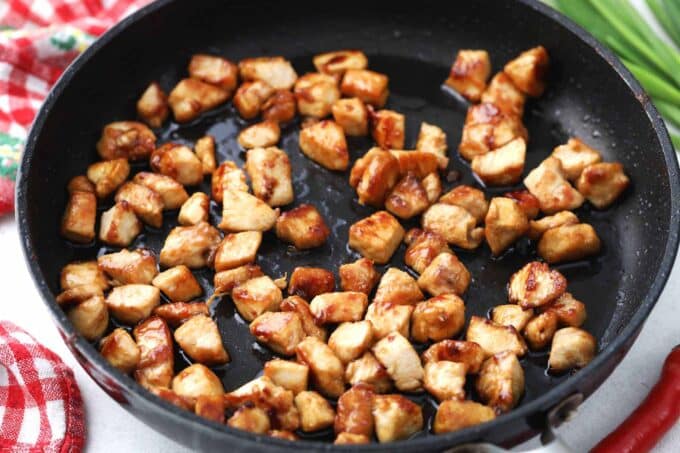
Stir-fry: Then, I add the ginger and peppers to the pan and fry for another 3 to 5 minutes.
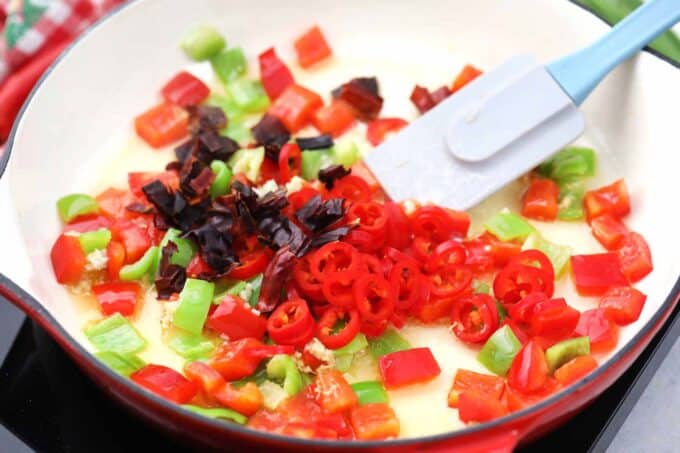
Add the sauce: Next, I add the sauce and let it come to a boil while stirring.
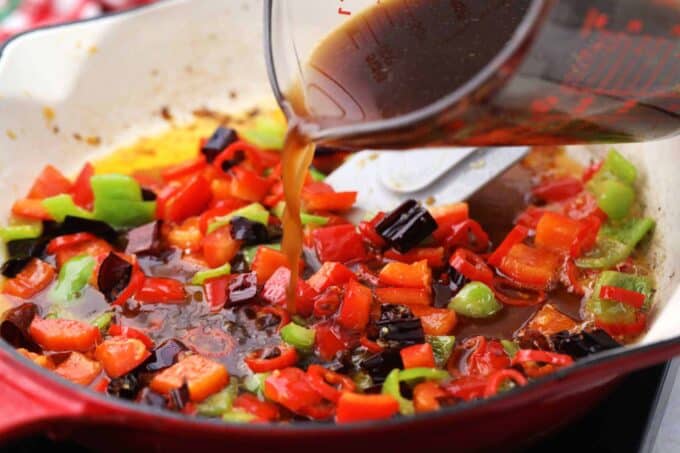
Combine: When it starts to thicken, I add the chicken back and cook for an additional 3 minutes.

Finish: I add the green onions and peanuts and let them cook for 2 minutes.

Enjoy: I serve Kung Pao Chicken stir-fry over white rice.
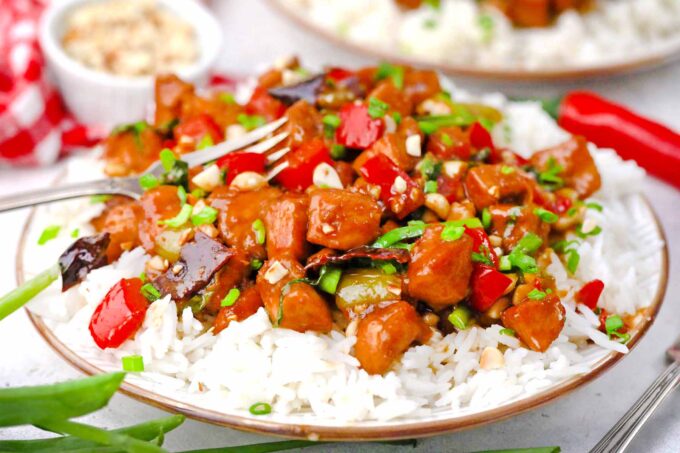
Expert tip
Some tips about chili peppers
Cooking with chili peppers can be challenging if you’re new to it. The first thing to know is always to wear gloves. The capsaicin oil in them can irritate the skin. Also, even when wearing gloves, never touch your eyes when handling peppers. Then, make sure to remove the seeds and rinse out the inside of the peppers. I like Anaheim peppers for their mildness because they rank as low as 500 on the Scoville scale.
When it comes to dried chilies, the larger, darker varieties are milder. Look for ones that are deep purple or black. I like ancho peppers because they are dried poblano peppers. They are mild with a smoky, sweet taste. Pasilla is a dried chilaca pepper with a mild, earthy flavor. Also, remember that no matter whether they are fresh or dried, the smaller the chilis, the hotter they are. Add a little at a time to see how spicy it gets.
More tips to consider
- Be sure not to cook the chicken for too long, or it will dry out, even if it has been marinated for a long time.
- The peppers determine how spicy the chicken will be, so choose them carefully.
- To find authentic Asian ingredients, look for an Asian market online. I have found the most varieties at the best prices at Weee! which is the largest online Asian retailer in the world.
- Make sure the sauce is not too runny by cooking it for at least three minutes, simmering the whole time.
- Taste the marinade before adding the chicken to ensure it’s not too sour.
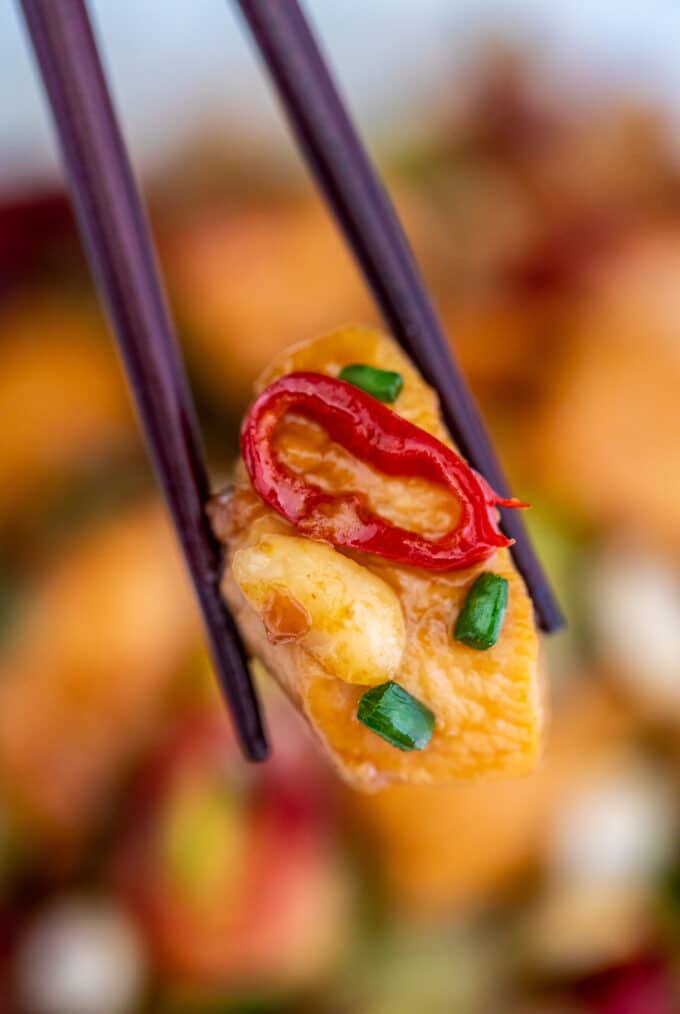
Recipe variations and add-ins:
- Different meat: Try this dish with pork, ham, or beef. It also tastes amazing with shrimp. This is a delicious sauce that pairs well with just about anything.
- Change the sauce: Experiment with the sauces you have on hand; I like this meal with an authentic Szechuan sauce.
- Add more vegetables: To make this even more hearty, toss in some mushrooms, baby corn, snow peas, broccoli florets, and cauliflower.
- Chinese vinegar: Alternatively, Chinese vinegar is a great authentic choice to try. I have used it several times, but my family prefers the sweetness of balsamic vinegar.
- Different nuts: Sometimes, I use cashews or slivered almonds instead of peanuts. It is perfect either way, but my favorite is with the almonds.
- Water chestnuts: Add water chestnuts to the mixture for an extra crunchy texture.
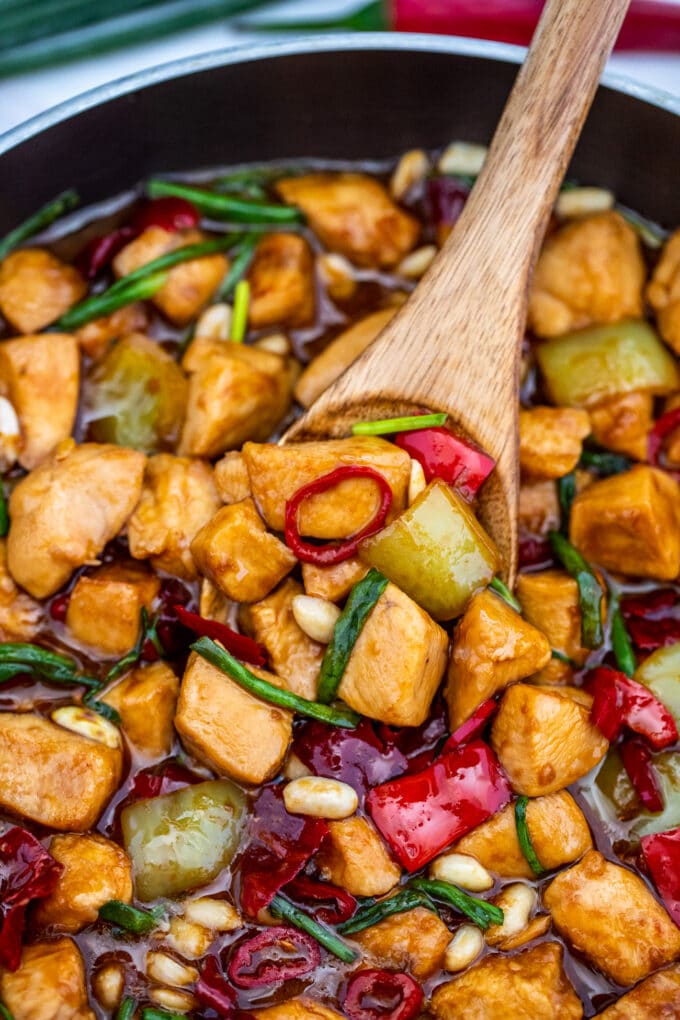
Serving suggestions:
Traditionally, Kung Pao chicken is served with rice, so I usually make either white steamed rice or homemade egg fried rice to accompany it. I also like to serve it with steamed broccoli on the side, sauteed Napa cabbage, or boiled cabbage.
For a healthier dish, I like to serve this with my low-carb cauliflower rice, which is tasty and nutritious. It also goes great on top of a bed of greens, or use lettuce leaves to make lettuce wraps. This lemon tart is the perfect creamy and refreshing dessert, especially paired with a spicy dish like this one.
How to store leftovers
- Refrigerate: Store it in an airtight container in the fridge for up to 4 days.
- Freeze: You can put this in freezer bags and store it in the freezer for up to 2 months. Make sure to remove any excess air and flatten the bags.
- To reheat: Thaw overnight in the refrigerator and then reheat in a skillet over medium heat until heated through. You can also reheat using the microwave.
- To make ahead: Follow this recipe except for adding the cornstarch to the sauce, as its thickening power degrades when stored or frozen. Reserve the garnishing, too. When it’s time to serve, add the cornstarch to thicken the sauce.
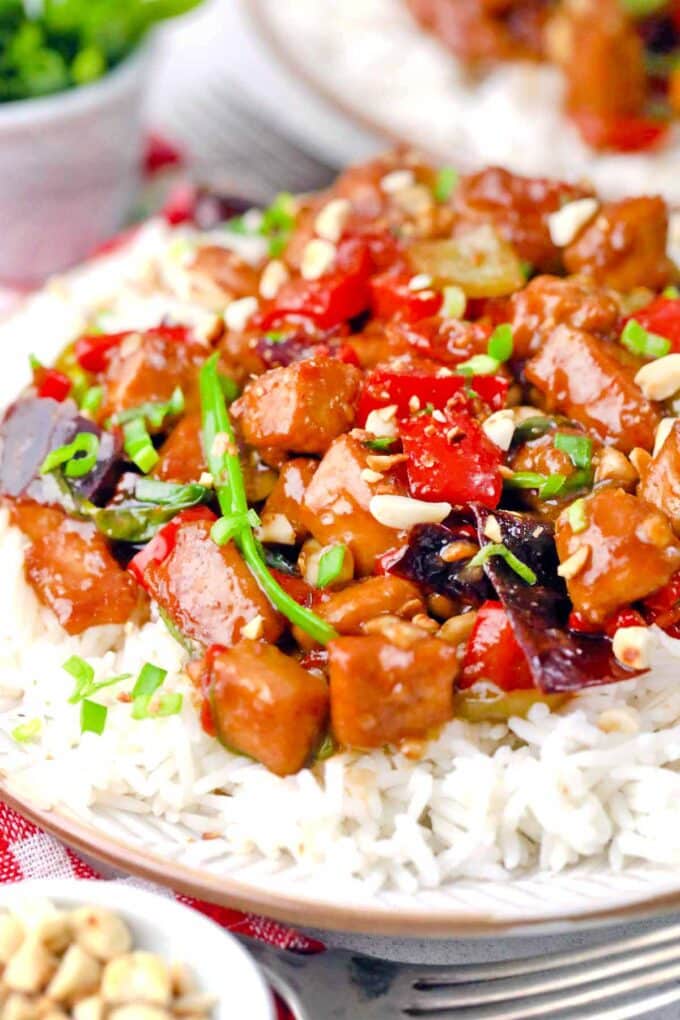
Frequently asked questions
Although marinating the chicken should help keep it from drying out, nothing can stop it from turning into chewy or rubbery meat if it is cooked for too long. That is the most important thing to remember when making this dish. Do not overcook the chicken. Only let it cook for a few minutes so it doesn’t get overdone; otherwise, the muscle fibers will contract and turn the tender meat into chewy leather.
It is probably because of too much cornstarch. This makes the sauce too thick and syrupy. It clings to the chicken pieces and will make it stick to everything. Try adding a bit more juice. Lemon or orange juice will work. Add a little at a time. First, add just a tablespoon. Do not add too much, or it will be too thin and need more cornstarch. Then, it needs to be cooked for a few more minutes while stirring constantly.
If the sauce is not cooked for long enough, the cornstarch slurry will not have enough time to thicken, regardless of the amount of cornstarch added. It needs about three or four minutes over medium-high heat to thicken the sauce. The liquid should be simmering the whole time. Continue to stir it frequently so it doesn’t stick to the bottom of the saucepan and remains free-flowing. Otherwise, it will end up with uneven thickening and sticky patches.
I use rice vinegar in my marinade to prevent this from happening. If a different type of vinegar is used, the chicken may pick up a sour flavor or taste too tangy. It may also be the sherry. Always taste the marinade before soaking the chicken in it. If it tastes too tart, don’t add the chicken to it. Try adding something milder. It could also be the dark soy sauce. Try it before using it. Some people do not like the flavor.
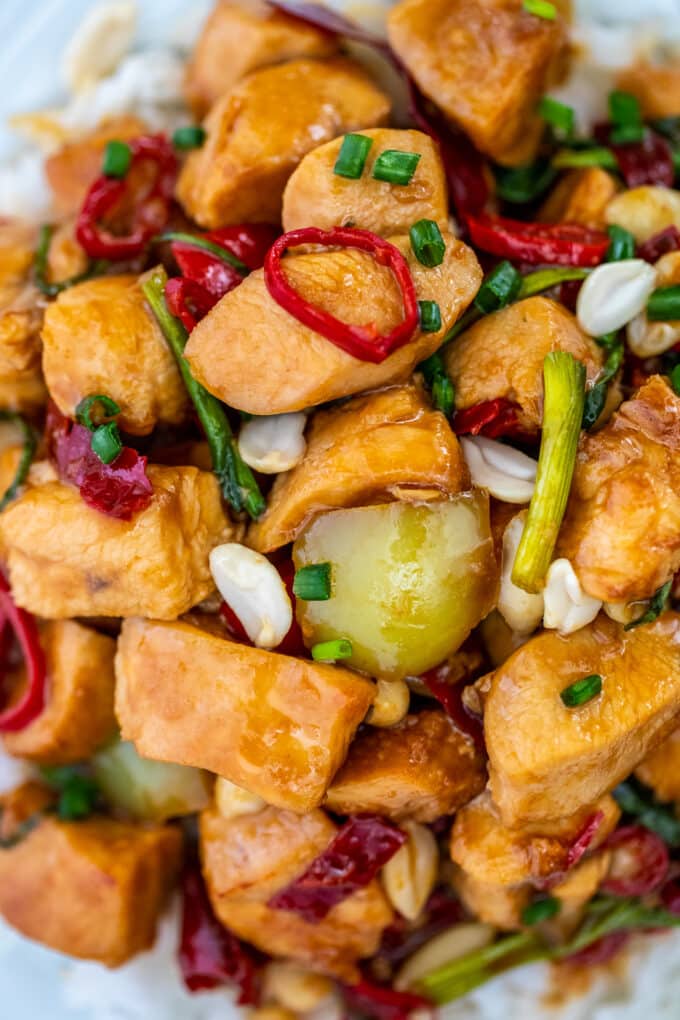
More Chinese recipes to try:
Loved this recipe? I’d love to hear from you! 💛 Leave a 5-star rating ⭐️ in the recipe card below and share your thoughts in the comments – I read and appreciate every single one!
Let’s stay connected! Follow me on Facebook, Instagram, Pinterest, and YouTube for more delicious, sweet and savory recipes. Have a question? Ask in the comments, and I’ll be happy to help! 😊 with love Catalina!
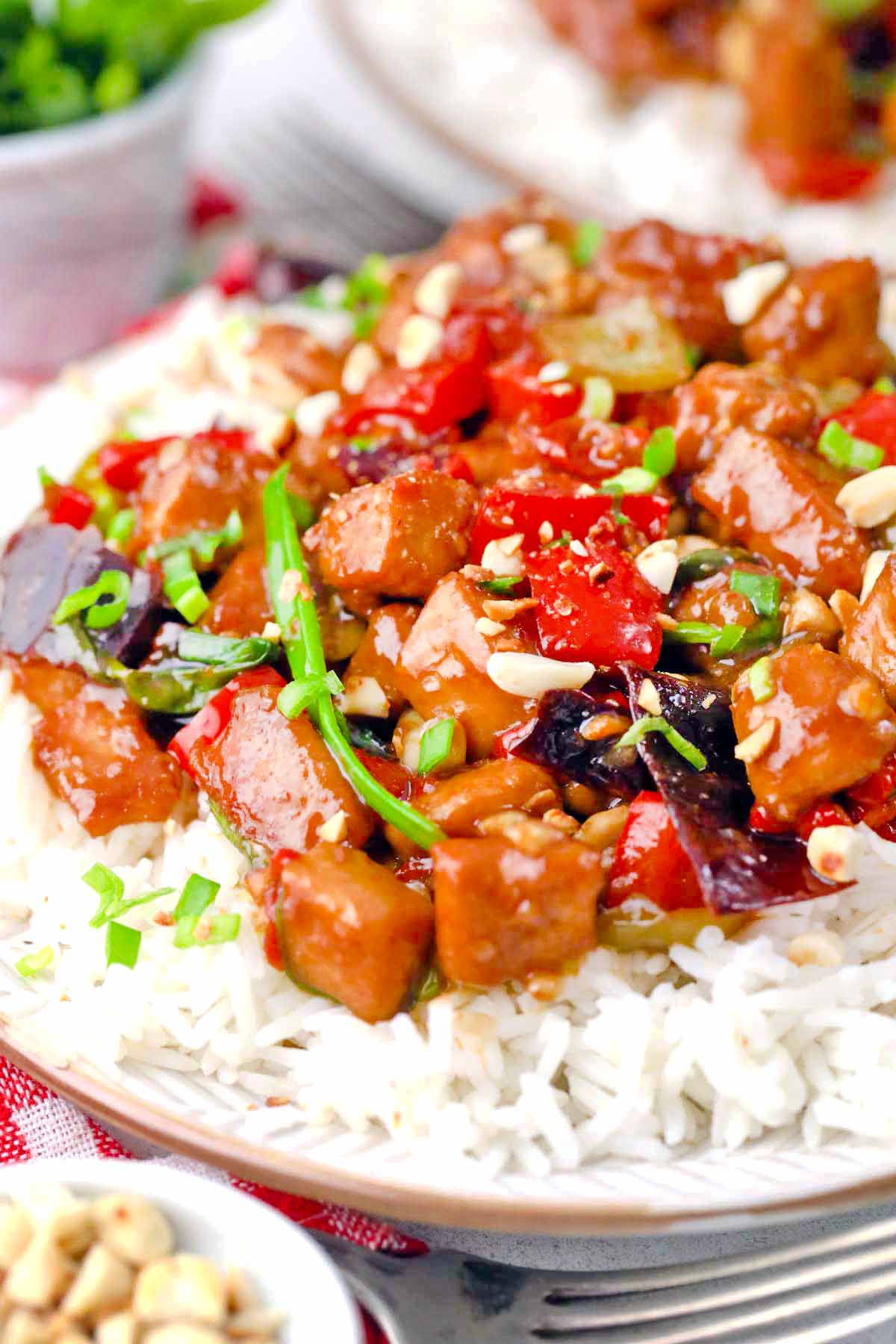
Kung Pao Chicken
Ingredients
Chicken:
- 2 pounds boneless/skinless chicken breast cut into 1-inch cubes
Marinade:
- 1 tablespoon dry sherry
- 2 tablespoons soy sauce
- 1 tablespoon rice vinegar
- 1 tablespoon sesame oil
- 2 tablespoons cornstarch
Sauce:
- 1/2 cup chicken broth low-sodium
- 1/4 cup soy sauce low-sodium
- 1/4 cup water
- 2 tablespoons dark soy sauce low-sodium
- 2 tablespoons balsamic vinegar
- 2 tablespoons dry sherry
- 2 teaspoons hoisin sauce
- 2 tablespoons brown sugar
- 1 tablespoon cornstarch
Stir Fry:
- 4 tablespoons vegetable oil divided
- 4 cloves garlic minced
- 1 tablespoon ginger grated
- 1/2 red bell pepper seeded and diced
- 1/2 green bell pepper seeded and diced
- 8-10 dried chilies cut into ½-inch pieces (use less if you prefer a milder dish)
- 2 fresh red chiles cut into rounds
- 1 stalk green onions cut into 1-inch pieces
- 1/2 cup peanuts roasted and unsalted
Instructions
Marinate:
- Combine all marinade ingredients in a shallow bowl. Add the sliced chicken, cover it, and let it marinate for 30 minutes if time allows.
Sauce:
- In a medium bowl, whisk together the sauce ingredients until the sugar is fully dissolved. Set the mixture aside.
Cook Chicken:
- Heat a large skillet or wok over high heat and add 2 tablespoons of oil. Once hot, add the marinated chicken. Fry it for 3-5 minutes, until golden brown. Remove from pan and set aside.
Stir Fry:
- Add the remaining oil to the same pan. Stir-fry the garlic, ginger, bell peppers, and both dried and fresh chili peppers for 3–5 minutes.
- Combine the prepared sauce and add it to the pan. Stir continuously and bring the mixture to a boil.
- Once the sauce has thickened slightly, add the chicken back and stir all the ingredients to coat them evenly. Cook for an additional 2-3 minutes, until the sauce has thickened further.
- Stir in green onions, peanuts. Cook for another 2 minutes.
- Serve with rice.
Video
Notes
Some tips about chili peppers
Cooking with chili peppers can be challenging if you’re new to it. The first thing to know is always to wear gloves. The capsaicin oil in them can irritate the skin. Also, even when wearing gloves, never touch your eyes when handling peppers. Then, make sure to remove the seeds and rinse out the inside of the peppers. I like Anaheim peppers for their mildness because they rank as low as 500 on the Scoville scale. When it comes to dried chilies, the larger, darker varieties are milder. Look for ones that are deep purple or black. I like ancho peppers because they are dried poblano peppers. They are mild with a smoky, sweet taste. Pasilla is a dried chilaca pepper with a mild, earthy flavor. Also, remember that no matter whether they are fresh or dried, the smaller the chilis, the hotter they are. Add a little at a time to see how spicy it gets.More tips to consider
- Be sure not to cook the chicken for too long, or it will dry out, even if it has been marinated for a long time.
- The peppers determine how spicy the chicken will be, so choose them carefully.
- To find authentic Asian ingredients, look for an Asian market online. I have found the most varieties at the best prices at Weee! which is the largest online Asian retailer in the world.
- Make sure the sauce is not too runny by cooking it for at least three minutes, simmering the whole time.
- Taste the marinade before adding the chicken to ensure it’s not too sour.

